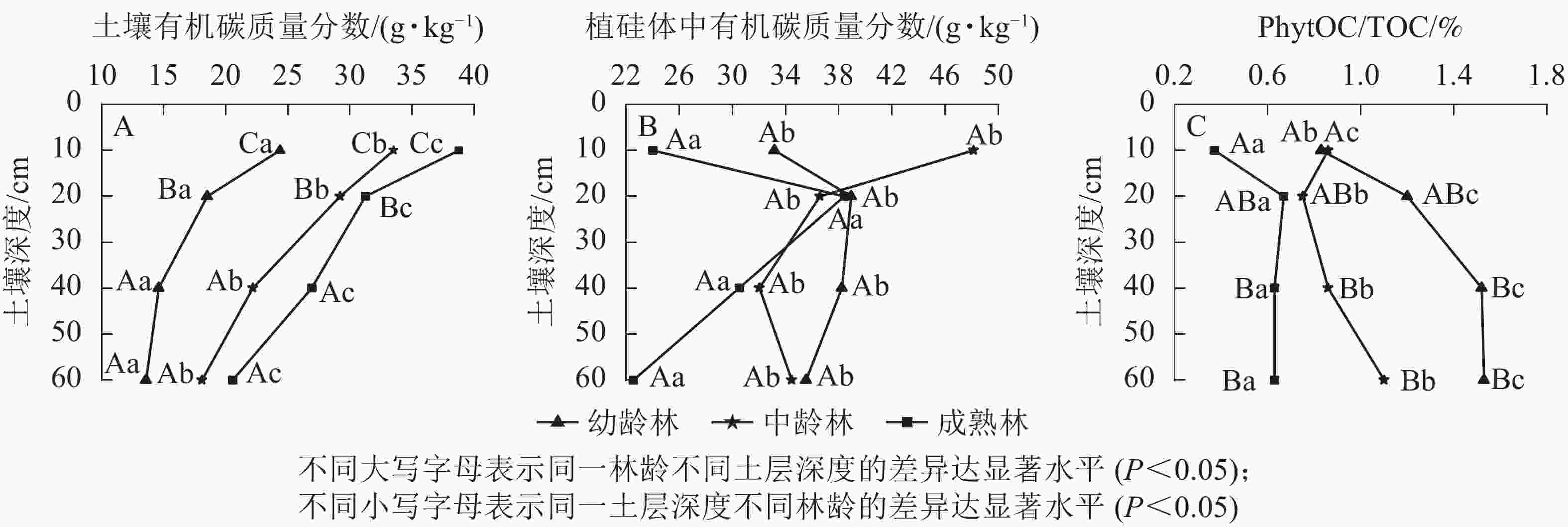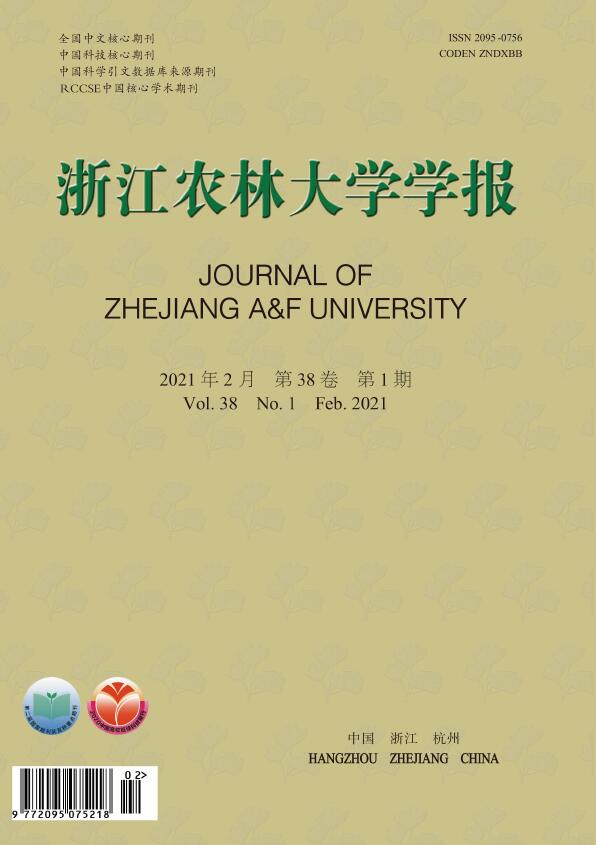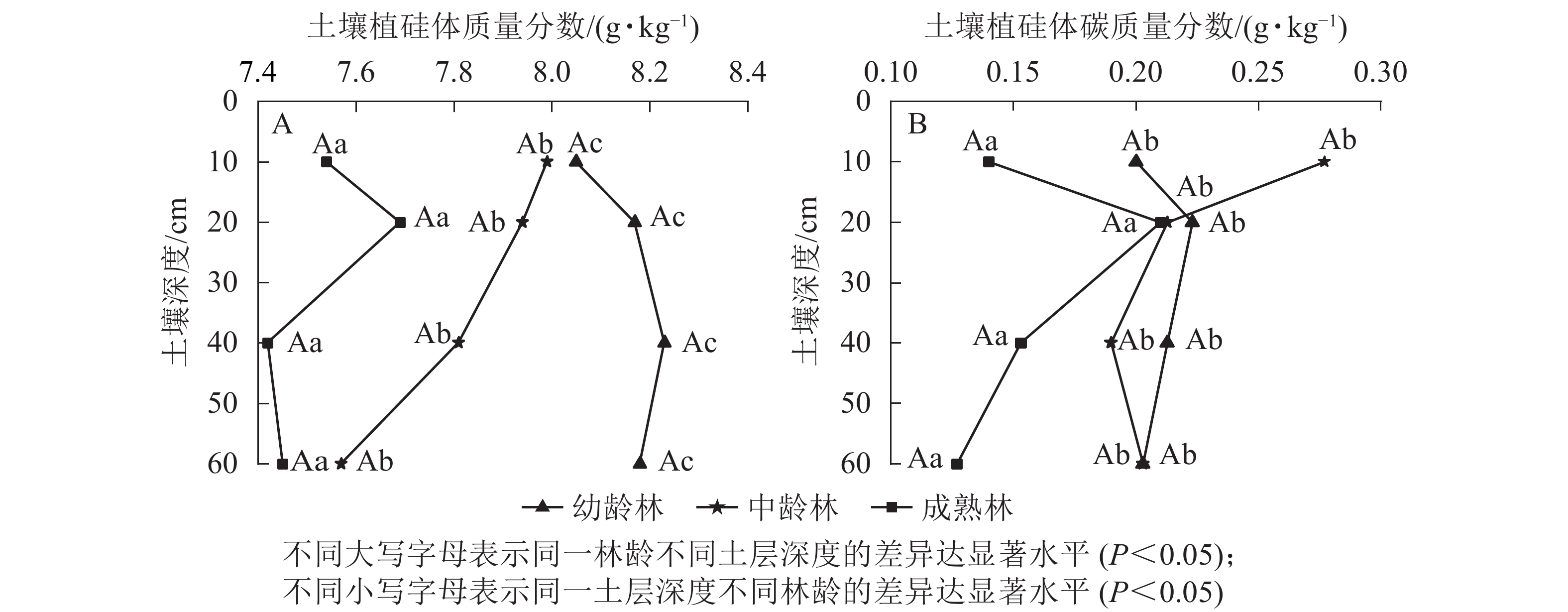-
全球陆地生态系统中最大的有机碳库即为土壤碳库,是陆地植被碳库的2~3倍、大气碳库的2倍[1-3]。土壤碳库的变化对大气二氧化碳浓度的影响显著,进而影响气候变化。研究表明:大约50%~90%的土壤有机碳是由周转时间约10 a的活性碳所组成的[4],而植硅体碳是除木炭、有机无机复合体以外稳定的碳,周转速率为200~13 300 a[5]。植硅体碳(PhytOC)是植硅体(phytolith)在沉淀过程中封存于植物细胞的有机碳,在植物死亡、腐烂后被分解释放到土壤中。植硅体及其封存的碳可在土壤或沉积物中长久稳定保存,因此土壤在植硅体碳封存过程中扮演着重要的碳库角色。植硅体是植物在生长过程中吸收土壤溶液中单硅酸[Si(OH)4],沉淀在各器官细胞内的非晶质二氧化硅矿物,具有很强的抗氧化性、抗腐蚀性和抗分解能力,可在土壤中保存千年甚至是万年。土壤本身并不生成植硅体碳,而是植物通过光合作用储存在各器官中。早期的碳循环研究一直没有评估植硅体碳的碳汇潜力。土壤中植硅体碳储量较小,但在全球长期的碳循环研究中其碳汇功能不可忽略。有关土壤植硅体、植硅体碳的研究,已从最初植硅体组成成分[6-7]、碳封存机制[8-9]和土壤植硅体及植硅体碳提取方法的探讨[10],到植硅体和植硅体碳在土壤剖面中的迁移和分布[11-12],再到植硅体碳稳定性,以及近年来关于某种特定植被类型土壤植硅体碳储量的估算等[13-15]。特别是植硅体碳封存方面的研究,已经成为新的研究热点,为人类应对全球气候变暖提供了新对策与碳汇途径。目前,关于土壤植硅体碳研究涉及的领域主要有森林[16-19]、湿地[20-23]、草原[24-26]等生态系统。森林植被类型主要以高富硅的竹亚科Bambusoideae植物为研究对象,且研究集中于热带和南亚热带区域。麻栎Quercus acutissima具有耐干旱、耐贫瘠的特点,是荒山瘠地的先锋树种和水土保持的优良树种,广泛分布于亚热带地区[27]。本研究以北亚热带麻栎林为研究对象,探讨不同林龄(幼龄林、中龄林和成熟林)麻栎林土壤的植硅体碳储量,为中国森林生态系统植硅体碳汇研究提供理论依据。
HTML
-
本研究区位于江苏省句容市境内,属北亚热带季风气候区,四季分明,光照充足。年均降水量1 057.0 mm,年际变化较大。研究区地处江淮丘陵地带,地形多为丘陵山地,起伏较平缓。土壤母质为第四纪下蜀组黄土状沉积物,类型以黄棕壤和山地黄棕壤为主,土层厚度一般为40~60 cm,土壤质地为中壤至重壤(Q3x),pH 4.5~5.0。森林植被属中国北亚热带东部区的落叶阔叶混交林。研究地是以麻栎为主的天然次生林,零星散布栓皮栎Q. variabilis、锐齿槲栎Q. aliena var. acuteserrata等;灌木主要有野蔷薇Rosa multiflora、牛鼻栓Fortunearia sinensis、华紫珠Callicarpa cathayana、枸骨Ilex cornuta和白檀Symplocos paniculata等;草本植物主要有爬山虎Parthenocissus tricuspidata、铁线蕨Adiantum capillus-veneris、白茅Imperata cylindrica、麦冬Ophiopogon japonicus和络石Trachelospermum jasminoides等。
-
本研究样地设置在江苏省句容市下蜀林场和句容林场,选取幼龄林(17 a)、中龄林(26 a)和成熟林(65 a)等3种不同林龄的麻栎混交林,于2017年7−8月在每个林地按坡位(坡上、坡中、坡下)选择3个调查样地(20 m×20 m),共9块样地进行调查。对麻栎林样地进行每木检尺,测量记录胸径、树高,确定标准木,并调查地形地貌以及林分特征等指标(表1)。
样地 林龄/
a坡度/
(°)坡位 林分密度/
(株·m−2)胸径/
cm树高/
m郁闭度/
%1 17 30 坡下 975 10.2 8.60 48 2 17 34 坡中 700 10.7 8.85 45 3 17 40 坡上 300 14.2 10.31 35 4 26 8 坡下 775 13.4 9.94 80 5 26 8 坡下 825 15.2 10.63 80 6 26 8 坡下 600 14.2 10.31 75 7 65 28 坡下 225 28.6 15.25 55 8 65 31 坡中 325 26.9 14.73 45 9 65 28 坡下 350 25.3 14.20 47 说明:幼龄林坡陡,土壤砾石含量为30%左右,多为禾本 科Gramineae草本植物;中龄林坡缓,土壤砾石含量 为20%左右,土壤紧实,灌草茂盛;成熟林坡陡, 土壤砾石含量为25%左右,草本植物多为络石 Table 1. Basic characteristics of sampting plots studied
本研究在每个样地内沿对角线分别在坡上、坡中、坡下各挖1个60 cm深的土壤剖面,按0~10、10~20、20~40、40~60 cm分层取样,并取原状土和袋装土带回实验室,测定土壤理化性质和植硅体碳。
-
将土壤样品置于通风阴凉处风干,去除根系、砾石,经研磨后过2.000、0.250、0.149 mm直径的筛网,用于分析。土壤基本理化性质测定:土壤容重采用环刀法;pH用电位法测定,土水质量比为1.0∶2.5;土壤砾石含量采用排水法;土壤颗粒组成采用激光粒度分析仪法;有效磷采用盐酸和硫酸溶液浸提法;碱解氮采用碱解扩散法;速效钾采用乙酸铵浸提-火焰光度法;有机碳质量分数采用重铬酸钾氧化-外加热法。麻栎林土壤基本理化性质见表2。
林龄 土壤深度/
cm土壤容重/
(g·cm−3)pH 有效磷/
(mg·kg−1)碱解氮/
(mg·kg−1)速效钾/
(mg·kg−1)有机碳/
(g·kg−1)砂粒/
(g·kg−1)粉粒/
(g·kg−1)黏粒/
(g·kg−1)幼龄林 0~10 1.23 4.88 4.78 99.7 149.8 24.37 826 164 10 10~20 1.28 4.72 4.10 72.3 148.2 18.53 572 402 26 20~40 1.30 4.60 2.91 42.0 133.6 14.59 607 353 44 40~60 1.37 4.56 2.33 32.3 113.4 13.61 614 339 57 中龄林 0~10 1.39 4.72 7.58 115.7 218.4 33.54 356 591 54 10~20 1.47 4.67 3.42 70.0 195.3 29.22 258 654 89 20~40 1.51 4.60 1.91 50.3 182.1 22.17 126 765 109 40~60 1.57 4.58 1.65 38.0 162.0 18.08 110 779 121 成熟林 0~10 1.37 4.55 7.51 229.0 226.7 38.77 460 475 66 10~20 1.40 4.51 5.74 135.3 189.4 31.27 370 545 85 20~40 1.46 4.49 3.39 100.3 186.0 26.94 398 467 135 40~60 1.56 4.48 2.33 83.7 165.8 20.58 410 447 155 说明:粒级划分采用国际制土壤粒级划分标准:砂粒(0.020~2.000 mm);粉粒(0.002~0.020 mm);黏粒(<0.002 mm) Table 2. Basic physical and chemical properties of the soil in Q. acutissima forests
有效硅质量分数采用柠檬酸提取-钼蓝比色法;土壤二氧化硅质量分数采用碱溶法-硅钼蓝比色法;植硅体质量分数采用湿式灰化法测定,并用WALKLEY-BLACK[28]方法检验植硅体外缘的有机碳是否完全除去,提取出的植硅体经干燥后称量得到植硅体质量,计算植硅体质量分数;植硅体碳质量分数采用碱溶分光光度法[29]。在测定样品的同时,加入土壤成分分析标准物质(GBW07405),检验其准确性。
-
土壤植硅体质量分数(g·kg−1)=植硅体质量(g)/土壤质量(kg);土壤植硅体碳质量分数(g·kg−1)=植硅体封存有机碳质量(g)/土壤质量(kg);植硅体中有机碳质量分数(g·kg−1)=植硅体封存有机碳质量(g)/植硅体质量(kg)。土壤植硅体碳储量
$({\rm{t}} \cdot {\rm{h}}{{\rm{m}}^{{\text{−2}}}}) = \displaystyle\sum\limits_{i = 1}^{n} {{K_i}} \times {\rho _{\rm{b}}}_i \times {C_i} \times \left( {{\rm{100 {\text{−}} }}{G_i}} \right) \times {\rm{1}}{{\rm{0}}^{{\text{−3}}}}$ ;土壤有机碳储量$({\rm{t}} \cdot {\rm{h}}{{\rm{m}}^{{\text{−2}}}}) = $ $\displaystyle\sum\limits_{i=1}^{n} {{K_i}} \times {{\rm{\rho }}_{\rm{b}}}_i \times {D_i} \times (100{\text{−}}{G_i}) \times {10^{{\text{−3}}}}$ 。其中:Ki为i层土壤深度(cm),ρbi为i层土壤容重(g·cm−3),Ci为i层植硅体碳质量分数(g·kg−1),Di为i层有机碳质量分数(g·kg−1),Gi为直径≥2 mm 的石砾所占的体积百分比(%)。 -
采用SPSS 22.0和Excel 2003进行数据统计分析,平均值计算采用加权平均法。采用最小显著极差(LSR)法对土壤不同土层的二氧化硅、植硅体及植硅体碳等质量分数进行方差分析和显著性检验(显著性水平P<0.05),采用Pearson法对土壤不同土层的二氧化硅、有效硅、植硅体、植硅体碳及有机碳变量间的相关关系进行分析,并用Origin 9.0软件绘图。
1.1. 研究区域概况
1.2. 样地设置与采样
1.3. 样品处理及测定方法
1.4. 数据处理
1.5. 统计分析
-
由图1A可知:麻栎林土壤不同土层有效硅质量分数为45.7~153.3 mg·kg−1,各林龄麻栎林土壤有效硅质量分数随土层深度增加而增大,各分层之间有效硅质量分数差异不显著;不同林龄麻栎林土壤有效硅质量分数差异显著(P<0.05),麻栎林土壤有效硅平均质量分数从大到小依次为幼龄林、成熟林、中龄林。麻栎林土壤不同土层二氧化硅质量分数为181.8~444.1 g·kg−1(图1B),不同林龄之间土壤二氧化硅平均质量分数差异显著(P<0.05);麻栎幼龄林和成熟林土壤二氧化硅质量分数随土层深度增加先增大后减小,中龄林土壤二氧化硅质量分数大致随土层深度增加而减小,各土层之间二氧化硅质量分数差异不显著。
-
麻栎林土壤不同土层植硅体质量分数为7.10~8.23 g·kg−1 (图2A),植硅体碳质量分数为0.09~0.29 g·kg−1 (图2B),幼龄林和成熟林土壤植硅体、植硅体碳质量分数随土层深度增加先增大后减小,而中龄林土壤大致随土层深度增加而减小,各土层之间植硅体、植硅体碳质量分数差异不显著。麻栎林不同土层植硅体、植硅体碳质量分数从大到小大致表现为幼龄林、中龄林、成熟林,不同林龄之间土壤植硅体、植硅体碳平均质量分数差异显著(P<0.05)。
-
由图3A可知:麻栎林土壤不同土层有机碳质量分数为13.60~38.77 g·kg−1,有机碳质量分数随土层深度增加而减小,各土层之间有机碳质量分数差异显著(P<0.05)。不同林龄麻栎林土壤有机碳平均质量分数从大到小依次为成熟林、中龄林、幼龄林,不同林龄之间土壤有机碳质量分数差异显著(P<0.05)。

Figure 3. Carbon contents, organic carbon contents in phytolith, and PhytOC/TOC in Q. acutissima forests
麻栎林土壤不同土层植硅体中有机碳质量分数为22.57~48.14 g·kg−1 (图3B),与植硅体、植硅体碳质量分数在土壤剖面中的分布规律和差异性一致,即幼龄林和成熟林土壤植硅体中有机碳质量分数随土层深度增加先增大后减小,而中龄林土壤植硅体中有机碳质量分数随土层深度增加而减小,各土层之间植硅体中有机碳质量分数差异不显著,不同林龄之间植硅体中有机碳质量分数差异显著(P<0.05)。土壤植硅体碳与有机碳质量分数比值(PhytOC/TOC)为0.36%~1.49%(图3C),不同土层之间PhytOC/TOC差异不显著,但各林龄之间差异显著(P<0.05)。不同土层植硅体碳中有机碳质量分数从大到小大致表现为幼龄林、中龄林、成熟林。
-
麻栎幼龄林、中龄林、成熟林土壤植硅体碳储量分别为1.16、1.47、1.15 t·hm−2(表3),幼龄林、中龄林、成熟林有机碳储量分别为 94.03、165.28、210.44 t·hm−2,各林龄之间差异不显著。幼龄林、中龄林、成熟林土壤的植硅体碳储量占有机碳储量的比例分别为0.80%~1.50%、0.73%~1.10%、0.36%~0.67%。
林龄 土壤深度/
cm有机碳/
(g·kg−1)植硅体碳/
(g·kg−1)有机碳储量/
(t·hm−2)植硅体碳储量/
(t·hm−2)Phytoc/TOC/% 幼龄林 0~10 24.37 0.198 26.29 0.21 0.80 10~20 18.53 0.223 17.60 0.21 1.19 20~40 14.59 0.214 23.42 0.34 1.45 40~60 13.60 0.203 26.71 0.40 1.50 总计 94.02 1.16 中龄林 0~10 33.54 0.278 37.30 0.31 0.83 10~20 29.22 0.215 34.20 0.25 0.73 20~40 22.17 0.188 50.07 0.43 0.86 40~60 18.08 0.198 43.71 0.48 1.10 总计 165.28 1.47 成熟林 0~10 38.77 0.139 47.78 0.17 0.36 10~20 31.26 0.208 34.53 0.23 0.67 20~40 26.94 0.154 65.18 0.37 0.57 40~60 20.58 0.123 62.95 0.38 0.60 总计 210.44 1.15 Table 3. PhytOC and organic carbon storages in different soil depths of Q. acutissima forests
-
由表4可知:土壤各层二氧化硅质量分数与植硅体、植硅体碳质量分数之间呈极显著正相关(P<0.01);土壤植硅体碳质量分数与植硅体质量分数之间呈极显著正相关(P<0.01);土壤植硅体碳质量分数与有效硅质量分数之间呈负相关,但未达显著水平(P>0.05);土壤植硅体碳质量分数与有机碳质量分数之间无显著相关关系(P>0.05);植硅体质量分数与有效硅质量分数之间呈显著正相关(P<0.05)。
变量 二氧化硅 植硅体 植硅体碳 有效硅 有机碳 二氧化硅 1 植硅体 0.534** 1 植硅体碳 0.606** 0.441** 1 有效硅 -0.126 0.372* -0.178 1 有机碳 -0.021 1 说明:*表示P<0.05;**表示P<0.01 Table 4. Correlation coefficients between the five variables of Q. acutissima forest soil
2.1. 麻栎林土壤有效硅、二氧化硅质量分数
2.2. 麻栎林土壤植硅体、植硅体碳质量分数
2.3. 麻栎林土壤有机碳、植硅体中有机碳质量分数和土壤植硅体碳与有机碳质量分数比值(PhytOC/TOC)
2.4. 麻栎林土壤植硅体碳储量
2.5. 相关性分析
-
本研究发现:各林龄麻栎林土壤有效硅质量分数随土层深度增加而增大,与发育于玄武岩[17, 30]、花岗岩[17]的土壤有效硅质量分数的剖面分布规律研究结果一致。本研究麻栎林土壤母岩属于第四纪下蜀组(Q3x)黄土状沉积物,可能是受淋溶等作用有向下迁移的趋势,或是下层母岩风化提高了土壤的有效硅质量分数,而黑钙土、栗钙土和草甸土[30]的有效硅质量分数随土层深度的増加呈现出先减小后增大的趋势。母岩直接影响土壤风化程度和理化性质,并进一步影响土壤有效硅质量分数,因此有效硅质量分数在不同土壤剖面中的分布具有差异性。
FISHKIS等[31]的研究认为:土壤中植硅体碳可向土壤深层迁移,迁移深度可达2.2 m;另有学者认为:植硅体和植硅体碳在土壤剖面表层中容易富集,不易向土壤深层迁移[15, 32]。本研究中麻栎幼龄林和成熟林土壤二氧化硅、植硅体、植硅体碳、植硅体中有机碳质量分数大致随土层深度增加先增大后减小,与中国东部森林[17]的研究结论一致;而中龄林大致随土层深度增加而减小,与东北地区[18]的研究结果一致。究其原因可能是中龄林坡度平缓、容重较大、黏粒含量及含水量较高,因此土壤胶粒等的吸附能力强,且土壤紧实,受淋溶作用影响较小,难以向土壤深层迁移。通常大孔隙越多,优先运移到土壤下层的水量越大[33],幼龄林和成熟林土壤砂粒含量较高、容重较小、孔隙大,有利于植硅体的迁移;幼龄林和成熟林坡度大,水动力条件充足,因而运移速度大,易于向土壤深层迁移。
PhytOC/TOC是衡量土壤植硅体碳稳定性的指标,随着土层深度的增加而增大,且植硅体碳的稳定性也随之增强[16]。本研究与北方阔叶林、针叶林[34]和亚热带森林[35]等土壤的研究均符合这一规律。由于有机碳在土壤中易于分解,且植硅体碳较稳定,有机碳分解速率快于植硅体碳的速率,因而PhytOC/TOC随土层深度的增加而增大。本研究不同土层中土壤有效硅、二氧化硅、植硅体、植硅体碳、植硅体中有机碳质量分数和PhytOC/TOC差异不显著,可能是受动物扰动、淋溶等外在因素导致其在剖面中运移而差异不显著,需进一步深入研究。
-
土壤各层二氧化硅与植硅体、植硅体碳质量分数极显著正相关,与大部分学者的研究结论一致,表明土壤中硅素与植硅体、植硅体碳质量分数密切相关。有学者通过向土壤中施加钢渣粉[36]、岩粉[37]等,提高土壤供应硅素的能力,以及提高植物根系对可溶性硅的吸收,进而增加植物组织中的硅量、植硅体与植硅体碳质量分数。土壤植硅体与植硅体碳质量分数极显著正相关,与张晓东[17]和杨杰[38]的研究结论一致;土壤植硅体与有效硅质量分数呈显著正相关,与中国东部森林玄武岩风化壳土壤的研究结论一致,但与花岗岩风化壳土壤[17]结论相反。本研究麻栎林土壤母岩属于第四纪下蜀组(Q3x)黄土状沉积物,硅的有效性及母岩对植硅体的形成影响显著。本研究认为:土壤植硅体碳与有机碳无显著关系,与杨杰[38]的研究结论不同。这可能是由于林分、林下植被以及土壤、地形等立地条件的不同所致。
-
相关研究表明:毛竹Phyllostachys edulis林[17]、散生竹林[38]、丛生竹林[39]和雷竹Phyllostachys violascens林[40]土层的植硅体碳储量分别为3.91、0.694~5.373、0.485~2.705和8.883 t·hm−2,板栗Castanea mollissima林、杉木Cunninghamia lanceolata林[17]土壤植硅体碳储量分别为2.67、1.18 t·hm−2,本研究麻栎林土壤植硅体碳储量为1.15~1.47 t·hm−2,可知竹类土壤的植硅体碳储量较高。通常植物种间元素含量差异最大的是硅元素,一般认为被子植物高于裸子植物,单子叶植物高于双子叶植物,而单子叶植物中的禾本科、莎草科Cyperaceae植物通常被认为是高富集硅的代表[41]。竹类为超富硅的禾本科植物,因此土壤植硅体碳储量较高。不同森林类型土壤植硅体碳储量受植被类型、林下植物、立地条件和生物量等的影响而具有一定差异,单子叶植物竹子的土壤植硅体碳储量比双子叶植物阔叶林高很多。
3.1. 土壤植硅体碳在剖面中的分布规律
3.2. 土壤二氧化硅、有效硅、植硅体和植硅体碳质量分数等的相关关系
3.3. 土壤植硅体碳储量与碳封存量
-
本研究中麻栎林幼龄林、中龄林与成熟林土壤理化性质及林下植被种类存在较大差异,表现出幼龄林与成熟林土壤的二氧化硅、植硅体、植硅体碳与植硅体中有机碳质量分数随土层深度的增加先增大后减小,有向土壤深层迁移的趋势;而中龄林则随土层深度的增加而减小,在土壤表层富集,表明不同的森林生态系统受多重因素的影响,土壤植硅体碳等在土壤剖面中的分布具有差异性。不同林龄麻栎林土壤植硅体碳储量为1.15~1.47 t·hm−2。这些结论可为中国北亚热带森林生态系统长期稳定的植硅体碳汇功能与植硅体碳循环研究提供参考,对于评价中国森林长期碳汇功能研究具有重要的指导意义。















 DownLoad:
DownLoad:

